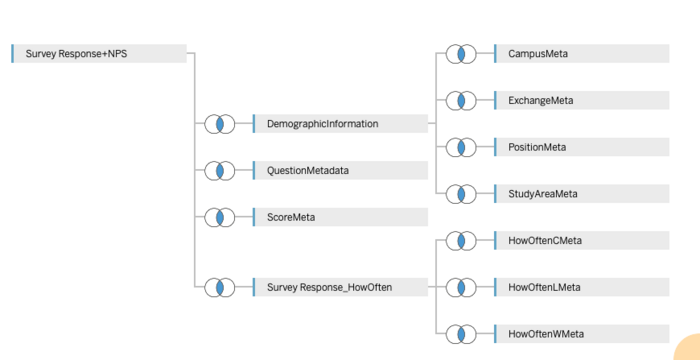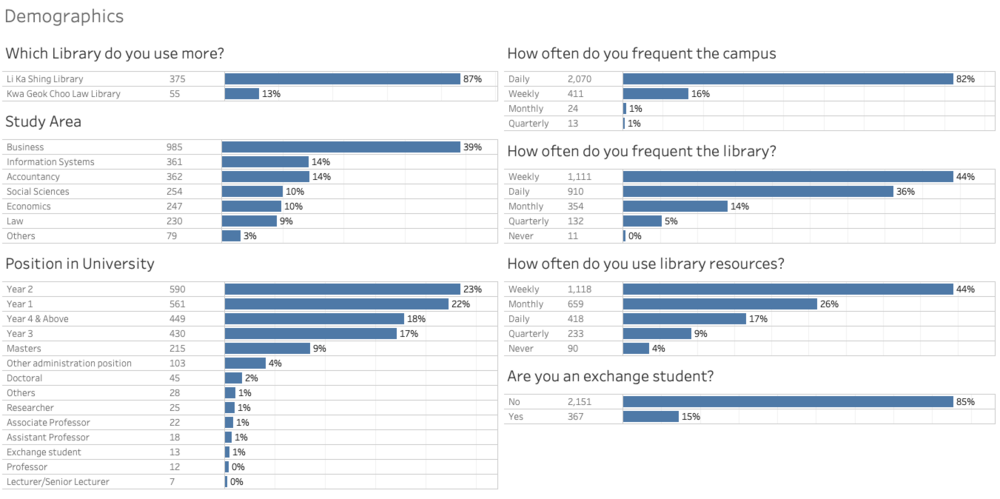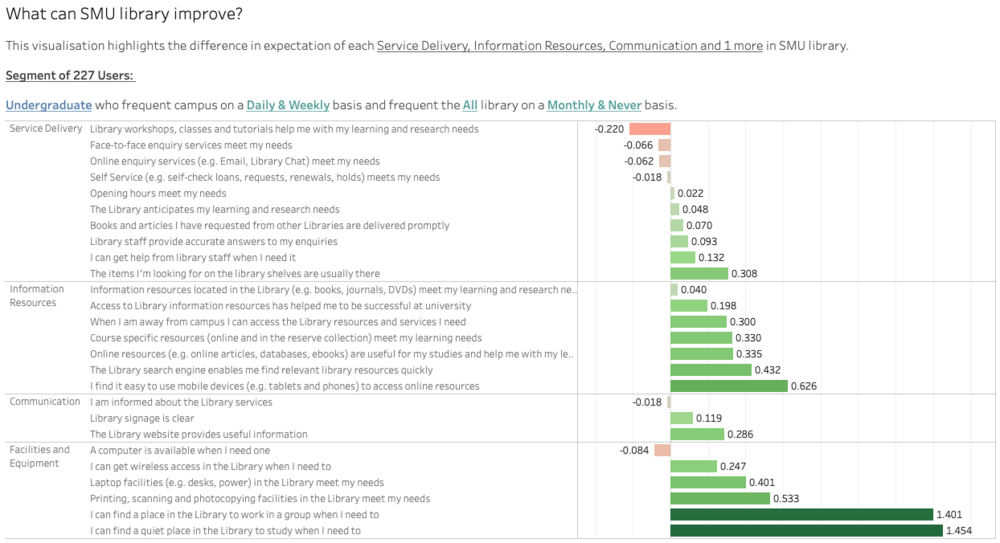IS428 AY2019-20T2 Assign DANIEL SOH WEI TONG
Contents
Problem and Motivation
Every two years, SMU Libraries conducts a comprehensive survey in which faculty, students and staff have the opportunity to rate various aspects of their services. The survey provides SMU Libraries with input to help enhance existing services and to anticipate emerging needs of SMU faculty, students and staff.
The reports are conducted by external vendors and presented in a written document accompanied by charts. With the large amount of data presented it is hard for the management to efficiently identify gaps within segment of their users and anticipate the emerging needs of SMU Libraries.
The interactive visualisation would be targetted at the following groups of users:
- SMU Management: To understand service gaps within SMU libraries and plan appropriate policies so that resources could be allocated efficiently.
- Library technology and Innovation Department: To derive insights from the data so that new policies or initiatives could be implement to improve the service of the libraries.
- Library Analytics department: To prepare the necessary reports and insights requested by internal or external sources.
Data Cleaning and Transformation
Interactive Visualisation
Dashboard
Key Demographics
Interactive Dashboard
Dashboard allowing users to explore different segments of survey respondents.
The graph represents the gaps in importance vs performance which is gap in value where the library can improve
Insights
To improve the library services, we look at two key segment of users and determine what are the causes behind why they choose not to use the library services.
Segments
1. Users who frequent the campus on a daily and weekly basis but only visited the library on a monthly or none basis
It would be useful to know why this segment of users who visit the campus often but choose not to visit the library. There could be value gaps that could be easily improved as they are often at campus.
2. Users who visits the library on a daily basis
It would be efficient way to boost user satisfaction on this core group of users that uses the library often.
Undergraduate Students
Segment 1: Frequent the campus often but not the library
Frequent the campus on a daily and weekly basis but only visited the library on a monthly or none basis
Problem: The top three issues that this segment of users face
- Lack of workshops to help with learning
- Lack of computers when they need one
- Lack face to face enquiry services
Recommendations:
- Lack of workshops to help with learning
- Lack of computers when they need one
- Lack face to face enquiry services
Segment 2: Frequent the library on a daily basis
Problem: The top three issues that this segment of users face
- Lack of workshops to help with learning
- Lack of computers when they need one
- Lack face to face enquiry services
Recommendations:
- Lack of workshops to help with learning
- Lack of computers when they need one
- Lack face to face enquiry services
Postgraduate Students
Segment 1: Frequent the campus often but not the library
Frequent the campus on a daily and weekly basis but only visited the library on a monthly or none basis
Problem: The top three issues that this segment of users face
- Lack of workshops to help with learning
- Lack of computers when they need one
- Lack face to face enquiry services
Recommendations:
- Lack of workshops to help with learning
- Lack of computers when they need one
- Lack face to face enquiry services
Segment 2: Frequent the library on a daily basis
Problem: The top three issues that this segment of users face
- Lack of workshops to help with learning
- Lack of computers when they need one
- Lack face to face enquiry services
Recommendations:
- Lack of workshops to help with learning
- Lack of computers when they need one
- Lack face to face enquiry services
Faculty
Segment 1: Frequent the campus often but not the library
Frequent the campus on a daily and weekly basis but only visited the library on a monthly or none basis
Problem: The top three issues that this segment of users face
- Lack of workshops to help with learning
- Lack of computers when they need one
- Lack face to face enquiry services
Recommendations:
- Lack of workshops to help with learning
- Lack of computers when they need one
- Lack face to face enquiry services
Segment 2: Frequent the library on a daily basis
Problem: The top three issues that this segment of users face
- Lack of workshops to help with learning
- Lack of computers when they need one
- Lack face to face enquiry services
Recommendations:
- Lack of workshops to help with learning
- Lack of computers when they need one
- Lack face to face enquiry services
Staff
Segment 1: Frequent the campus often but not the library
Frequent the campus on a daily and weekly basis but only visited the library on a monthly or none basis
Problem: The top three issues that this segment of users face
- Lack of workshops to help with learning
- Lack of computers when they need one
- Lack face to face enquiry services
Recommendations:
- Lack of workshops to help with learning
- Lack of computers when they need one
- Lack face to face enquiry services
Segment 2: Frequent the library on a daily basis
Problem: The top three issues that this segment of users face
- Lack of workshops to help with learning
- Lack of computers when they need one
- Lack face to face enquiry services
Recommendations:
- Lack of workshops to help with learning
- Lack of computers when they need one
- Lack face to face enquiry services




